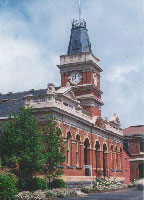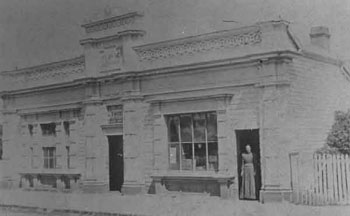
Township of Buninyong, Victoria, Lithograph by Henry Winkles, 1852
Botanic Gardens | Cemetery | De Soza Park | Town Hall (Restoration)
Adams' Store & Bakery | Brydon & Hedrick Store | Buninyong Brewery | Buninyong Town Hall | Buninyong Uniting Church | Caffrey Blacksmith | Eagle Hotel

Township of Buninyong, Victoria, Lithograph by Henry Winkles, 1852


(left): Central business district, 1890's, showing the Crown Hotel on the left and the former National Bank on the right;
(right): Central business district in 2001, taken from the same position

The Italianate Town Hall, Council Chamber and Court House
complex was built in 1886. The architects were Tappin, Gilbert
and Dennehy and Richard Rennie was the builder. The
Buninyong Court operated in this building from 1887, replacing
the earlier court house in Cornish Street, to 1980 when the
court was declared redundant. It was later used as the meeting
chamber of the Shire of Buninyong.
In December 1993 the Local Government Board recommended a new
super Council for greater Ballarat. This signalled the end of
the Shire of Buninyong, which held its last meeting in April
1994. The Court House was placed in the custodianship of the
Buninyong and District Historical Society in 1995, becoming its
headquarters.
Click Town Hall restoration to see photos of the beautifully restored interiors of the Town Hall.

The Whykes family began their butchering business near
Durham Lead in 1864. This substantial brick shop was built in
1897. The business was finally sold in 2000, and the shop became
a restaurant.
The 2 storey brick building's central position can be seen in the streetscape (right), taken on a Festival day.
Built in 1861 and registered with Heritage Victoria, it now operates as the Buninyong Information Centre. The former reading room contains pictorial interpretation and well researched text of Buninyong's early history in a series of panels. The building also houses a shop at the side.


(left) Buninyong Library, 1870's (right) Old Library, 1990's, after restoration
This was an early mining site. It contained the tannery
dam, supplying the Buninyong Tannery.
During the 1980s it was
turned into a public park, thanks to community effort.
Built as the Presbyterian Church in 1860, it replaced an earlier church built in 1847.
Built in 1861. The Church of England and Ireland began in Buninyong in 1857 when the surviving Sunday School was built.
Dates from 1853-1858
Mount Buninyong is important as a natural landscape, especially the Crater, with its botanical interest. The mount, which is 745 metres above sea level, is listed on the Register of the National Estate. Mt Buninyong is one of the most distinctive volcanic features of the Central Highlands group of newer volcanoes.

The precinct, incorporating the former Court
House and the Gong, is registered with Heritage
Victoria. Ten acres includes the Gong, a lake in five acres. The former stone Courthouse contains the story of the building and site with illustrations on display panels. The area was reserved from 1860.
View of former stone Courthouse from rear
Was opened in 1874 as a school to
accommodate 500 pupils.

1874 Photograph of Buninyong State School
Dating from the 1850s, it is built on the shores of the Gong.
Runs from Forest St. Buninyong (Tennis pavilion built on platform) to Union Jack Gully, including culverts and bridges.
Located on Buninyong-Mt. Mercer road, just out of Buninyong, on right hand side. Established in 1838, it later became the site of the Buninyong Gold Mining Company.
Traces of the diggings
can be seen along the side of Sandy's Hill Rd, just south of
Buninyong, especially near the area where Brennan's Rd. meets
Sandy's Hill Rd. The Green Hill diggings is the shallow end of
the Durham Lead.
The lead was opened up in March 1856, with 3000 men there within
a few days
Buninyong (Crown land).
Pastoralists came and settled in the area in 1838,
and by the 1840s a small settlement developed at the foot of the
mount from which it took its name. By 1847 the need was seen for
a boarding school for children of rural workers who radiated out
from Buninyong to the Pyrenees and to Portland Bay.
The Rev. Thomas Hastie was called to Buninyong in
1847 to become the first Presbyterian minister, and soon the
first inland boarding school in Victoria was established under
his management.
The spring was the water source for the minister,
his family, the school and the early church and was designated
as a Water Reserve and Reserve for Public Recreation.
(Sometimes called Mt.Innes or Hastie's Hill)
A World War One memorial.
A seat had been placed at the highest point which commands an
excellent view of the township, and this became known as the
Mayoral Seat. In February 1894 George Innes, pioneer, bequeathed
adjoining land to the citizens of Buninyong.
In 1918 trees were planted as a memorial to soldiers of World
War One. The area became known locally as Birdwood Park (named
after General Birdwood, Commander of the Australian forces in
France.)
The area has been incorporated into the Buninyong
Walking Trail, with descriptions included in booklets and
tourist brochures.
A Buninyong town map, dated 1856,
designates the area with "very fine perennial spring". Herriott
St. marked the boundary of small housing allotments, and the
large block bounded by Herriott, Cornish, Somerville and
Warrenheip Sts. was not subdivided. It is likely that George
Coleman gave his name to the springs.
In 1872 the site was gazetted as a water reserve. The 1983
Coleman-Sutherland Buninyong Conservation study recommended that
the area be protected as an area of natural beauty and it is
incorporated into the Ballarat Planning Scheme in 1998.
(Formerly known as the Highland Ground) Warrenheip St.
Buninyong celebrated its Scottish heritage from 1857 when its
Highland Society was formed, to organise the annual Highland
Games on this site every New Year's Day.
The Duke of Edinburgh,
visiting Buninyong on 13 December 1867, was so impressed by a
highland fling danced by one of the locals that he consented to
become the Patron of the Highland Society, and the ground was
allowed to style itself the Royal Highland Ground.
In 2008, after a prolonged battle against threats of housing development, the management of Royal Park, was handed over to a local community group, Friends of Royal Park, who are establishing native plantings and a community garden. See FORP's website for the latest information about the redevelopment of Royal Park.
(Buninyong-Yendon Road, Pound
Creek Rd.) next to George Innes's original house, on crown
land.
This is an important site for birds and in earlier times
was an Aboriginal camping site.
Located in the middle of the unmade part of Nolan St,
Buninyong, near Winter St.
By local tradition, this is the site
of Aboriginal meetings. The tree is hundreds of years old and
pre-dates white settlement.
Durham Lead Rd, Buninyong.
This was the home of
Francis Moss, nurseryman, famous developer of apple trees.
On the Midland Highway, between Buninyong and Sebastopol, it is one of Victoria's early cemeteries, having been surveyed in 1850 and used from 1852. A pioneer doctor was buried there in 1853, also many early pioneer residents of Buninyong.
The old burial ground predates the cemetery, burials taking place there from 1844. It is in Learmonth Street, not far from the Crown Hotel.
Opposite Buninyong Cemetery.
Hiscock's Gold monument nearby, erected in 1897 on Queen
Victoria's jubilee, is close to the spot where local blacksmith
Thomas Hiscock found gold in August 1851.
The Imperial Gold Mine site shows remains of large scale gold
mining activity.
In 2001 our Society unveiled a plaque in Hiscock's Gully Rd.to mark the 150th anniversary of the discovery of gold. Take the road opposite Buninyong Sand and Soil and travel up to the crest of the hill and you will come to the site on your left hand side.
Gold Protest Plaque In August 2005, the Ballarat Reform League Inc. unveiled a plaque nearby in Hiscock's Road to mark the site of the first protest against the gold license on the Victorian goldfields, which took place in Buninyong in August 1851.
See the Ballarat Reform League website for more information.
Henderson's Lane, on the outskirts of
Buninyong
This area, with its walking trail, incorporates remnants of
gold mining activity in a natural area, with wildlife returning
to the forest.
In the grounds of the Magpie School, beside
the creek.
This is the site of first meeting of the Wesleyan
Church in 1853 and an important early mining site.
For further information on any of these sites, contact the Society at PO Box 98, Buninyong, 3357